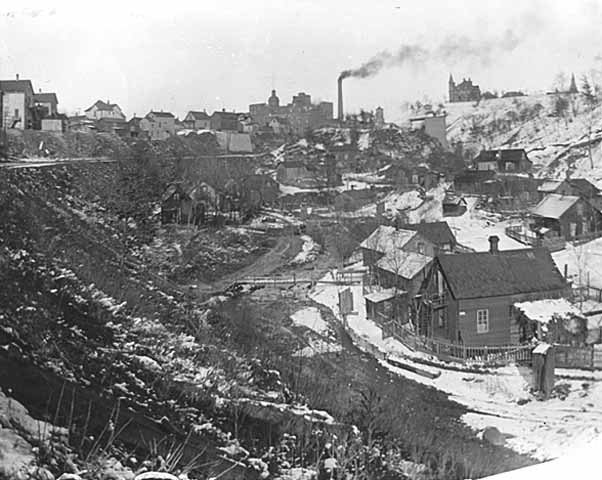Swede Hollow
We’ve all seen the headlines about homeless encampments in the Twin Cities. It seems like one is being cleared or moved every few months. But did you know that Swede Hollow, now a park in Saint Paul, was effectively a homeless encampment for over 100 years?
Desperate for a New Home
In 1846, three families from Sweden built shacks along the ravine called Trout Brook. The creek was deep below the bluffs that separated Lowertown Saint Paul and Dayton’s Bluff. Over time, hundreds of Swedish immigrants joined them and their community was given the nickname Svenska Dalen or Swede Hollow.
By the time many immigrants made it to Minnesota, they were out of money and barred by discrimination from most jobs until they could learn English. In the Hollow, they had no electricity, no running water, but they were surrounded by their Swedish culture, language and traditions until they could find stability. Their expenses stayed low and men found jobs with the nearby railroads and breweries while women and children worked in laundries or cleaning homes.
No one “owned” the houses. If someone moved out, someone else moved in. Small “fees” were paid to the city and officials looked the other way allowing the below-standard housing to exist. As the immigrants’ situations improved and they saved up a little moeny, they moved up out of the Hollow and into homes in nearby neighborhoods.
Changing Faces
Through the years, the ethnic culture of the Hollow changed. Political pressure in southern and eastern Europe before WWI brought Poles and Italians to the Hollow. By the 1930s, it was Mexican immigrants being recruited for cheap labor on sugar beet farms who needed homes during the off season. The faces changed, but conditions stayed the same: no heat, no water, no electricity. The 1950s, with a newfound emphasis on health and safety standards, saw a citywide crackdown on encampments and the city cleared the Hollow and burned the remaining homes.
Today, the area has been turned into a park. Walking and bike paths wind through the Hollow and education signs reminds us of the lives that were once centered around the little creek.
There always has been and always will be people who - for a wide variety of reasons - are at the very bottom of the societal ladder and have to struggle their way up. The stories from Swede Hollow are a testament to all of the immigrant families who made the climb.
Stories of Success
More than a few of the residents of Swede Hollow were able to save up their money, find good jobs, raise their families and build successful lives in the community around them. Some of the businesses around the edges of the area now called the Bruce Vento Nature Sanctuary were founded and run by former Swede Hollow dwellers.
Morelli’s Market - James Morelli and his family lived in the Hollow until they could open their Italian specialty grocery in 1915. They lived in an apartment over the store.
Yarusso Bros. was opened in 1933 as the Square Deal Cafe by Italian immigrants Francesco and Dora Yarusso (and their 14 children). They had arrived in the Hollow in 1904, but by 1911 were living in a house on Decatur Street. The next generation changed the name to Yarusso Bros. The same sauce and the same Bocce courts are still used today.











